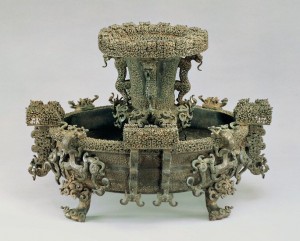View of Chinese Bronze Ware
 Bronze is the earliest of all alloys produced by the human race. In China, the earliest bronze ware were produced in the late period of the primitive society, and those produced during the Shang-Zhou period, in large quantities with the production techniques rated as better than ever before, highlight the social estate system practiced at the time. Bronze ware used before the Qin-Han period fall into three categories – those used at sacrificial ceremonies held by the state and aristocratic families, those for daily use by aristocrats and those used as funerary objects. Bronze articles for practical use include weapons, musical instruments, cooking utensils, and food, wine and water containers, as well as ornamental articles on horse chariots.
Bronze is the earliest of all alloys produced by the human race. In China, the earliest bronze ware were produced in the late period of the primitive society, and those produced during the Shang-Zhou period, in large quantities with the production techniques rated as better than ever before, highlight the social estate system practiced at the time. Bronze ware used before the Qin-Han period fall into three categories – those used at sacrificial ceremonies held by the state and aristocratic families, those for daily use by aristocrats and those used as funerary objects. Bronze articles for practical use include weapons, musical instruments, cooking utensils, and food, wine and water containers, as well as ornamental articles on horse chariots.
Bronze weapons unearthed so far are mostly swords, axes, axe-spears and dagger-axes. Bells in complete sets known as  bianzhong and large bells known as bo are the most typical bronze musical instruments played at sacrificial ceremonies and on other important occasions. Tripods and quadripods with hollow legs (li), which originated from prehistory cooking utensils, were used to boil whole animal carcasses for sacrificial ceremonies and feasting. Rules based on the social estate system were strictly followed with regard to the use of bronze ware. Nine tripods and eight food containers known as gui were allowed on occasions presided over by the “Son of of Heaven in rank may use seven tripods and six guis or five tripods and four guis. In short, the number of bronze containers decreased progressively according to the degrading ranks of the users. There were also stringent rules on the size and weight of the utensils for users of each rank. Wine sets are in greater variety than any other kind of bronze ware we have found so far – possibly because people of the Shang-Zhou period were fond of drinking wine. The earliest bronze wine sets include jue (wine vessel with three legs and a loop handle), jia (round-mouthed wine vessel with three legs) and hu (squaremouthed wine containers). Many wine containers take the shape of birds or animals.
bianzhong and large bells known as bo are the most typical bronze musical instruments played at sacrificial ceremonies and on other important occasions. Tripods and quadripods with hollow legs (li), which originated from prehistory cooking utensils, were used to boil whole animal carcasses for sacrificial ceremonies and feasting. Rules based on the social estate system were strictly followed with regard to the use of bronze ware. Nine tripods and eight food containers known as gui were allowed on occasions presided over by the “Son of of Heaven in rank may use seven tripods and six guis or five tripods and four guis. In short, the number of bronze containers decreased progressively according to the degrading ranks of the users. There were also stringent rules on the size and weight of the utensils for users of each rank. Wine sets are in greater variety than any other kind of bronze ware we have found so far – possibly because people of the Shang-Zhou period were fond of drinking wine. The earliest bronze wine sets include jue (wine vessel with three legs and a loop handle), jia (round-mouthed wine vessel with three legs) and hu (squaremouthed wine containers). Many wine containers take the shape of birds or animals.